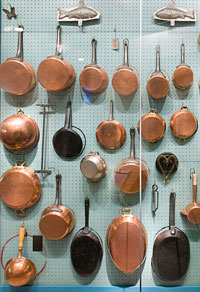Julia Child's Copper Pots: A Homecoming in Copper
 Copper pots from Bon Appétit: Julia Child's Kitchen at the Smithsonian
Copper pots from Bon Appétit: Julia Child's Kitchen at the SmithsonianPhotograph by Richard Strauss, Smithsonian Institution.
Copper pots and pans have long been a staple of the most well known cooks the world over and some even consider it to be the nobility of kitchen cookware. In fact copper cookware and utensils have been documented as far back as 3,000 years ago. So when Julia Child selected copper pots for her own home and kitchen in Cambridge, Mass., which served as the set for three of Child's cooking television series, people took notice. Her copper cookware hung behind her on a blue-painted peg board and the visual could not be understated, sort of like bling for the kitchen. Even today home cooks have copper pots displayed in their kitchens, telegraphing not only quality and beauty, but lasting value.
The National Museum of American History in Washington DC recently acquired thirty worn but beautiful copper pots as well as utensils that belonged to Julia Child. The new acquisition, which completes the Julia Child kitchen is on display in the exhibition, Bon Appétit! Julia Child's Kitchen at the Smithsonian. "Like all cooks, she had certain memories associated with many of her tools and utensils," explains Rayna Green, Co-curator of Julia Child's Kitchen at the Smithsonian. "Those memories came from the places where she had lived and cooked during her time in France. In the case of the copper pots, most of them came from E. Dehillerin, (the well-known cooking) store in Paris," Green says. Even today the store continues to sell an abundance of copper cookware.
Julia Child and her husband Paul lived in France between 1948 and 1952 as she studied French cooking and acquired her copper pans and pots. She continued to use her copper pots for 45 years following their return to the United States. In her autobiography, My Life in France, she wrote about the pegboard: "It did my heart good to see rows of gleaming knives and copper pots at the ready." She understood that specific tools are necessary for specific tasks. "Like many people well trained in cookery, she knew that copper distributes the heat evenly in the pan, thus for the kind of precision that French cooking demands, copper is generally the best medium," Green says. "The French and Italians have been making and using copper pots for a very long time and copper has a long association with both fine cooking and home cooking in those countries," she added.
Beginning in 2001, the museum staff laboriously disassembled, cataloged and then reassembled the contents in Child's home and her kitchen now lives on in the museum gallery. The kitchen display is supplemented with videos and photographs, allowing visitors to explore Child's early life and career. "All of the experience evokes an interesting and, as we've come to see it over the years, incredibly personal and collective appreciation for kitchens, for pots and kitchen bookshelves, for refrigerator magnets, for giant knives, and above all, for Julia," Green acknowledges.
Resources:
Also in this Issue:
- High Art: Perspectives of a Roofer Turned Copper Artist
- Julia Child's Copper Pots: A Homecoming in Copper
- Dana Draper: Painting with Patinas
- Huan Public Copper Sculpture to Debut in San Francisco’s Civic Center
